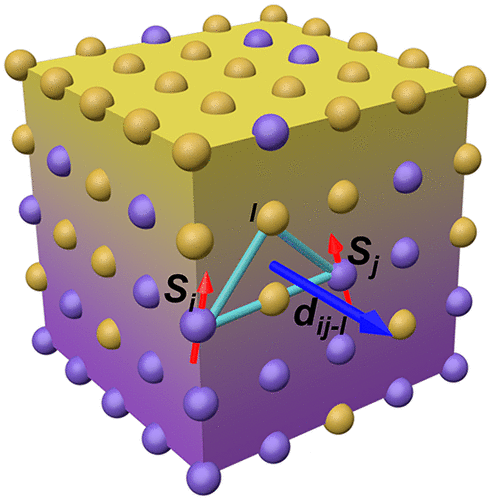The Dzyaloshinskii–Moriya interaction (DMI) arising in the magnetic systems with broken inversion symmetry plays an essential role in topological spintronics. Using atomistic spin model simulations of an intriguing type of DMI emerging in the films with composition gradient (g-DMI), it is demonstrated that that both the strength and chirality of g-DMI can be controlled by the composition gradient even in the disordered system.

Schematic representation of a thin film of alloy comprising magnetic (magenta) and non-magnetic (yellow) atoms with a linear vertical compositional gradient. One of DMI vectors arising from interaction between spins mediated by neighboring heavy atom.
While it is usually believed that the disorders like the intermixing and dusting of elements at interfaces are detrimental to the interfacial DMI, there are a number of experiments showing of a significant DMI (termed g-DMI hereafter) in the amorphous thin films with a composition gradient breaking the inversion symmetry. For instance, the measured DMI values show a linear relation with the film thickness, signifying a bulk nature of g-DMI despite in the thin films. In addition, several experiments have suggested that the combination of g-DMI and spin–orbit torques (SOT) may lead to the current-induced magnetization switching in a single magnetic layer, although the microscopic mechanisms remain not well explored. To have an in-depth understanding of g-DMI, several fundamental questions remain to be cleared up: How is the g-DMI controlled by the composition gradient? What about the distribution of g-DMI over the thin film? How do the magnetic state and the spin dynamics get affected by the g-DMI?
The aforementioned questions have been clarified using systematic and comprehensive theoretical analysis of the g-DMI based on the atomistic spin calculations. First, it turns out that in contrast to the interfacial DMI, the g-DMI can be engineered by the composition gradient without the demand of a high-quality interface for the enhancement of total DMI. Next, the linear composition gradient can lead to almost uniform distribution of g-DMI inside the bulk layers of thin film. Indeed, the layer-resolved analysis of g-DMI unveils the additive nature inside the bulk layers and clarifies the linear thickness dependence of g-DMI observed in experiments. Due to this additive nature of g-DMI, increasing the film thickness is beneficial to increase the total DMI. Furthermore, the g-DMI leads to topological magnetic structures such as spin spirals and skyrmions and the g-DMI driven field-free SOT switching, both of which are crucial toward the practical spintronic device applications. Compared to the interface DMI with its properties determined by constituent elements and ordering of the atoms at the interface, both the strength and chirality of g-DMI are continuously tunable by the composition gradient, thus being advantageous for practical applications. These results elucidate the underlying mechanisms of g-DMI, open up a new way to engineer the topological magnetic textures, and may lead to more exotic spin phenomena induced by the g-DMI in the future.
Team: Theory & simulation
Collaboration: Unité Mixte Phys. CNRS/Thalès (France), NIMTE and Nanjing Univ. (China)
Funding: EU Horizon 2020 (Graphene Flagship), MOST, Zhejiang PNSF, NNSFC & CAS (China), Institut Universitaire de France (IUF)
Further reading: Gradient-Induced Dzyaloshinskii–Moriya Interaction, J. Liang, M. Chshiev, A. Fert and H.-X. Yang, Nano Lett. 22, 10128 (2022), hal-03942584
Contact at Spintec: Mairbek CHSHIEV




